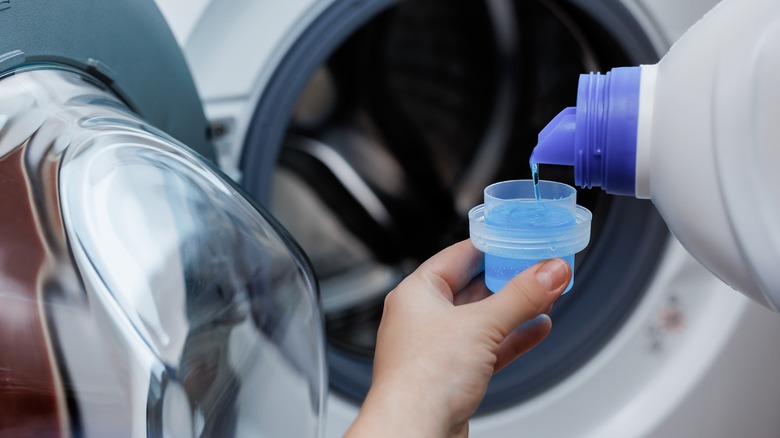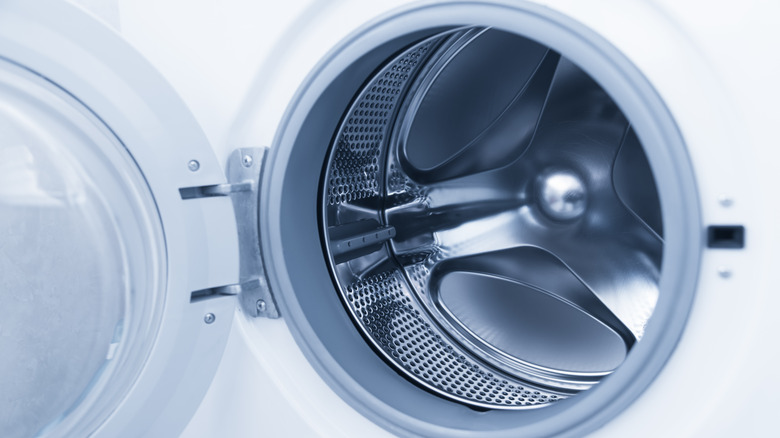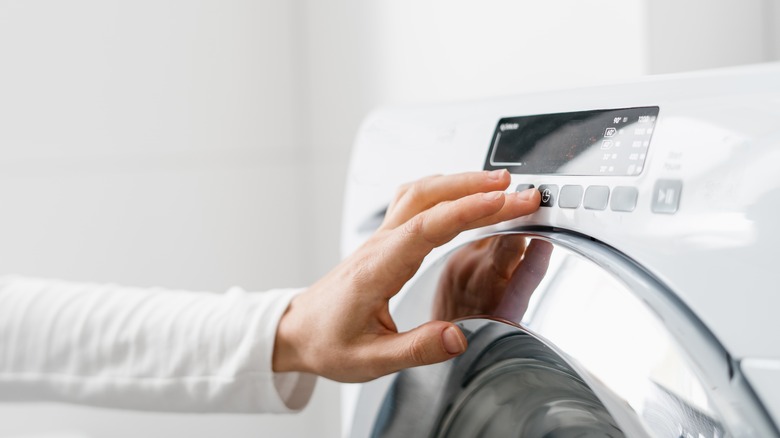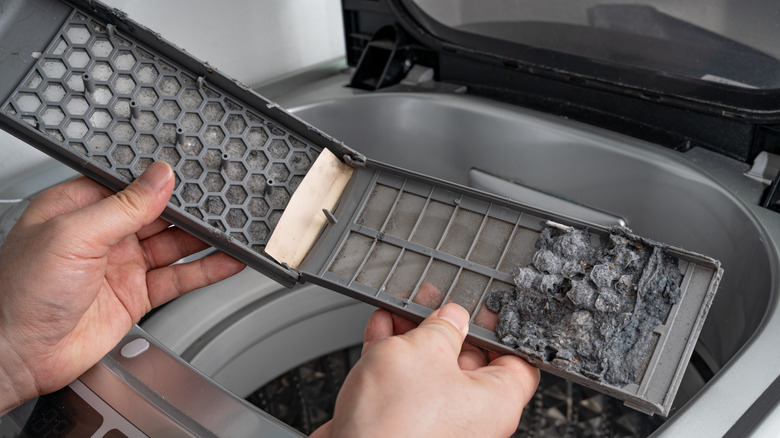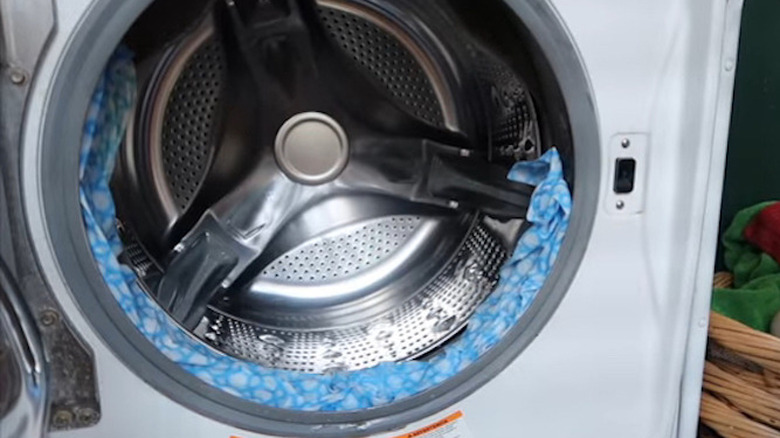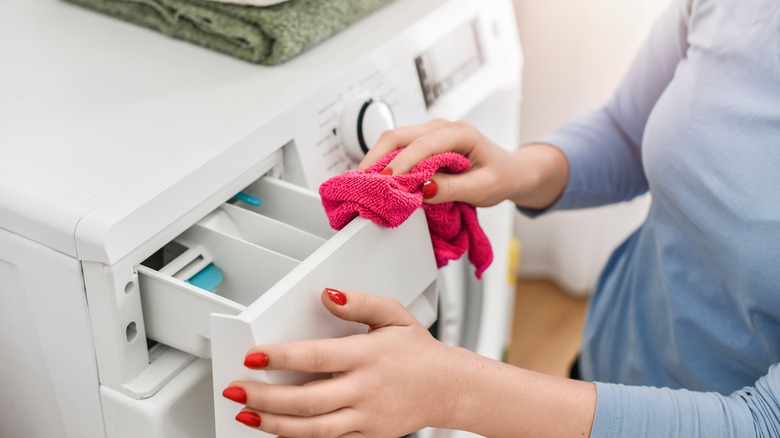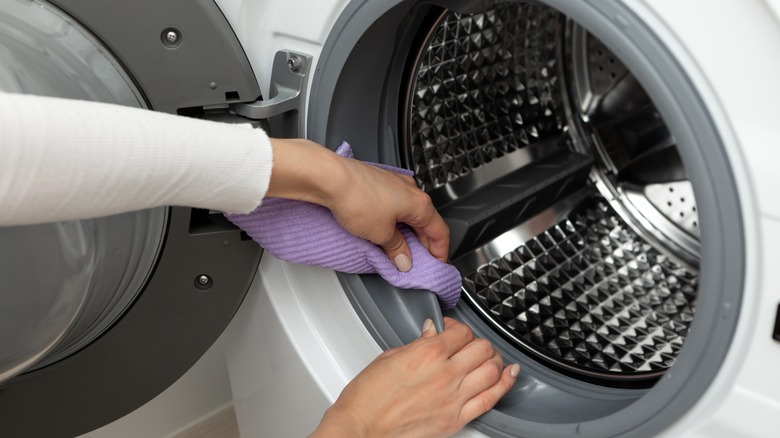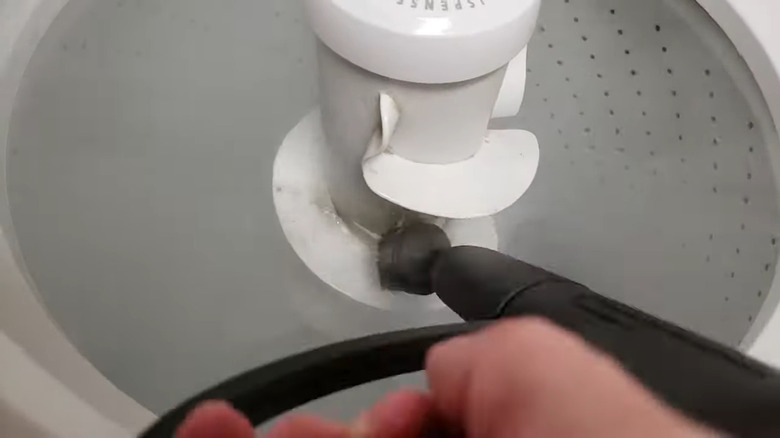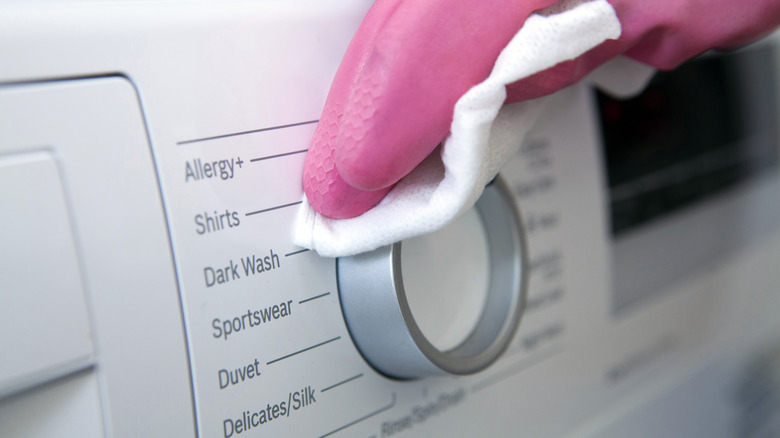8 Cleaning Hacks To Help Keep Your Washing Machine Sparkling Clean
It seems counterintuitive that the very appliance designed for cleaning clothes needs to be cleaned itself now and then. However, the reality is that even cleaning appliances get dirty with frequent use (and misuse). Chances are there's been a time when you've opened a washing machine only to discover a musty odor. That's likely the result of the growth of mildew and mold. In particular, it's common for the gasket in front-loading washing machines to accumulate dirt, moisture, and detergent, which results in a breeding ground for bacteria and mildew. The filter, which often goes unchecked, can be a source of odors when it collects debris over many washes. Even the washing drum can begin to smell, in part due to the growth of odor-causing bacteria, which is exacerbated by using too much detergent.
While cleaning can help resolve this most of the time, there are other times when it's not enough. In these cases, a smelly appliance may be a sign of more serious problems. For instance, if your laundry machine smells of sewage rather than musty mildew, that's a clear indicator you have a drainage issue. If there's standing water left behind in the washing machine drum after a cycle, this points to clogged hoses. If you notice these issues, call a repair person or consult a DIY solution to keep your laundry machine in working order. Otherwise, a musty or moldy washing machine can be addressed by adopting a new cleaning routine or deploying a few moisture-fighting tactics.
Leave the door open
First of all, it's important to recognize that mold and mildew can only thrive when conditions are right for their growth. What is the most vital factor these fungi need to survive? Moisture. So, your first line of defense against mold and mildew in the laundry room is letting your appliance dry out in between uses. You can do this simply by leaving the washing machine door ajar after a cycle. Remove wet laundry from the drum promptly, then put it in the dryer or hang to dry. After you've done that, crack the washing machine door to allow any remaining water to evaporate for at least a few hours.
If your laundry room has an exhaust fan, you can also use that to help cut down on indoor humidity. Switch on the exhaust when you start your washing machine cycle. Then, leave the fan running for at least 10 to 15 minutes after you've emptied the washing machine. These steps may sound simple, but they're also crucial. After all, if you're not addressing the conditions that support mildew growth, you're limiting the success of any cleaning products you may throw at the problem.
Run an empty load
If leaving your washing machine door ajar hasn't solved the problem of your smelly washing machine, it could be that there's mold and mildew needing to be zapped from the washing machine drum. Vinegar is an excellent choice for banishing mold. It is one of the gentlest cleaners regarding side effects on the human body, yet one of the most powerful when fighting fungi. While you could spray and wipe down the interior of the washing machine, adding it to the wash cycle would be easier. (It should be noted that while vinegar is great for cleaning the washing machine drum, it's not ideal for cleaning gaskets. Gaskets can prematurely deteriorate when exposed to vinegar.)
Pour a couple of cups of vinegar into the laundry detergent dispenser. Alternatively, you can use bleach to amp up the cleaning power. In that case, add a half cup of bleach to the dispenser, then switch on the wash cycle. However, never mix vinegar and bleach in the same load, as this could potentially be dangerous. Whichever cleaning agent you choose will break up mold or detergent residue that could be feeding bacteria. Depending on how often you use your washing machine, you can run an empty load as a weekly or monthly preventative against odors. That said, it's also important to use less detergent, not more, during your regular washes to reduce the need for these regular cleaning interventions.
Clean the filter with dish soap
Mention cleaning the laundry machine lint trap, and chances are folks will assume that you mean emptying the dryer lint trap. However, some laundry machines also have lint traps, and they can get pretty messy if they are not cleaned regularly. The lint trap in a washing machine fulfills a function similar to that of the dryer lint trap, and it can become clogged with use. A clogged lint trap can lead to bad smells and prevent proper drainage. So remember to clean yours on a regular basis. If you're not sure where to find your lint trap, check your owner's manual (if you still have it) or visit your manufacturer's website for more information.
Once you've located the lint trap, you'll need to remove it. (Only attempt to remove a washing machine lint trap when the machine is powered down.) For front-loading washing machines, empty the drain hose of any water left behind from the last wash. You can catch this water in a bucket and dispose of it. Then, remove the filter from the drain. Built-up lint can be lifted away with your fingers or use a brush, particularly for filters that can't be removed. However, if your filter is removable, it's better to rinse it in hot, soapy water before returning it to your machine. Dish soap is a good choice to cut through whatever gunk has been left behind on your filter.
Wrap the gasket in a towel
It's a truth universally acknowledged: One of the grossest spots on a front-load washing machine is the gasket. While the gasket provides a water-tight seal that keeps dirt, water, and debris inside the machine during a cycle, some of these same things are drawn into the crevices of the gasket. There, they can encourage the growth of bacteria and mildew. We don't need to tell you that this results in a laundry room that feels less than fresh. Bleach is a great helper in banishing the gunk. But the question is: How best to apply it to the round and awkward-to-reach gasket?
The answer is to use towels. Towels or cleaning rags should be dunked in a 1:1 mixture of bleach and hot water. Pull the rubbery gasket open slightly to find an opening. Then, line the soaked and lightly wrung towels into this pocket. Let the towels sit for 15 to 30 minutes to allow the bleach to work its magic and loosen any build-up. Then, repeat this process on the remaining portion of the untreated gasket. When you're done, pop the towels in the washing machine and run a cycle. This will clean the towels while using any remaining bleach to freshen the washing machine drum. When the cycle ends, remove everything from the wash, and then wipe the gaskets to remove any residue left behind.
Clean the detergent internal dispensers
By right, the laundry detergent dispenser should be the cleanest part of the laundry machine. In reality, sticky detergent residue collects in this area, making it a magnet for grime. Luckily, these dispensers often pop up, at least if you're using a newer front-load washing machine. Removing the dispenser allows you to clean it thoroughly and then replace it in the machine.
To clean the dispensers, first run hot water over them. Next, you can simply wipe them with a washcloth or microfiber cloth to remove residue. If that's not enough to budge stuck-on detergent or dirt or to reach into the corners, take a toothbrush to the area and scrub gently. Select a soft-bristle toothbrush for this job to minimize your risk of scratching the plastic. The same basic guidance holds when cleaning built-in dispensers. Only, instead of removing the dispenser and rinsing it under the sink, you can simply wipe it with a cloth or scrub it with a brush. Repeat this process every ten washes or about once a month to minimize the build-up of detergent residue.
Dry the gasket between washes
Obviously, laundry machines are a trap for humidity. That goes without saying. However, you should be able to manage humidity with proper ventilation through a window, dehumidifier, or exhaust fan or by leaving the laundry machine door open. By doing these things, moisture should evaporate quickly enough that mildew cannot fester. That said, if humidity and moisture continue to be a problem, you may need to step up your efforts to banish them and stop mildew in its tracks. So, the next tip you can try is to manually dry the surfaces in your washing machine after you've run a load of laundry.
The most important area to dry first is the gasket. The gasket traps water and leaves little room for it to evaporate quickly. Peel open the gasket slightly, then run a washcloth or microfiber cloth over the area to eliminate moisture. You can also use this moment to dry the interior of the door as well. You may even want to wipe the inside of the washing machine drum as well. If that's too much trouble, you can also opt to leave the door open to allow water to evaporate.
Steam clean the wash drum
The drum of a washing machine can accumulate the residue of whatever goes in, whether dirt, laundry detergent, or fabric softener. In a top-load washing machine, you may see signs of this along the top of the drum or along the middle agitator. You can try to polish the drum. There are also YouTube channels that show how to use a steam cleaner to break up residue and restore the drum and agitator to a state of cleanliness.
If you don't already own a multi-surface steam cleaner, you can find affordable options in stores or online. They're also handy to have around for other uses beyond just polishing the interior of your washing machine; they can also be used to clean tile and grout. Of course, you don't need a steam cleaner to clean a washing machine drum, but it does reduce the amount of work you have to do to get yours to sparkle (or at least smell fresher).
Wipe down the exterior surfaces
Don't neglect the exterior after cleaning all the interior parts of your washing machine, from the drum to the filter to the detergent dispensers. Using a soft microfiber cloth and vinegar, wipe down the exterior of the machine. White vinegar can cut through dirt or laundry detergent residue, and microfiber cloths won't leave streaks behind. Focus also on cracks and crevices, such as those around the doors, drawers, and the window of a front-load washing machine. Wipe those clean as well.
Also, polish up the dials or keypads you press every time you run a load of laundry. On closer inspection, you may be surprised at how dirty these surfaces can get. For that matter, it may also astonish you how much the mess escapes your notice in day-to-day life. Prevent future grime build-up on your laundry machine exterior by making these steps part of your regular cleaning routine. You can keep your appliance clean by following these steps and avoiding other unwise practices, like storing dirty laundry in the washing machine.
